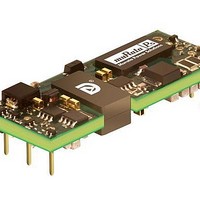UWE-15/5-Q12P-C Murata Power Solutions Inc, UWE-15/5-Q12P-C Datasheet - Page 19

UWE-15/5-Q12P-C
Manufacturer Part Number
UWE-15/5-Q12P-C
Description
DC/DC TH Q12-15V UWE
Manufacturer
Murata Power Solutions Inc
Series
UWEr
Type
Isolated with Remote On/Offr
Datasheet
1.UWE-3.320-Q12PB-C.pdf
(23 pages)
Specifications of UWE-15/5-Q12P-C
Output
15V
Number Of Outputs
1
Power (watts)
75W
Mounting Type
Through Hole
Voltage - Input
9 ~ 36V
Package / Case
8-DIP Module, 1/8 Brick
1st Output
15 VDC @ 5A
Size / Dimension
2.30" L x 0.90" W x 0.38" H (58.4mm x 22.9mm x 9.7mm)
Power (watts) - Rated
75W
Operating Temperature
-40°C ~ 85°C
Efficiency
91.5%
Approvals
CAN, CSA, EN, IEC, UL
Product
Isolated
Output Power
75 W
Input Voltage Range
9 V to 36 V
Input Voltage (nominal)
12 V
Output Voltage (channel 1)
15 V
Output Current (channel 1)
5 A
Isolation Voltage
1.5 KV
Package / Case Size
C77
Output Type
Isolated
Output Voltage
15 V
Lead Free Status / RoHS Status
Lead free / RoHS Compliant
3rd Output
-
2nd Output
-
4th Output
-
Lead Free Status / Rohs Status
Lead free / RoHS Compliant
Other names
811-2227-5
Soldering Guidelines
Murata Power Solutions recommends the specifi cations below when installing these
converters. These specifi cations vary depending on the solder type. Exceeding these
specifi cations may cause damage to the product. Your production environment may dif-
fer; therefore please thoroughly review these guidelines with your process engineers.
Input Fusing
Certain applications and/or safety agencies may require the installation of
fuses at the inputs of power conversion components. Fuses should also be
used if the possibility of sustained, non-current-limited, input-voltage polarity
reversals exist. For MPS UWE DC/DC Converters, you should use fast-blow type
fuses, installed in the ungrounded input supply line. Refer to the specifi cations
for fuse values.
be observed by the installer. For system safety agency approvals, the convert-
ers must be installed in compliance with the requirements of the end-use
safety standard, e.g., IEC/EN/UL60950-1.
Input Undervoltage Shutdown and Start-Up Threshold
Under normal start-up conditions, devices will not begin to regulate until
the ramping-up input voltage exceeds the Start-Up Threshold Voltage. Once
operating, devices will not turn off until the input voltage drops below the
Undervoltage Shutdown limit. Subsequent re-start will not occur until the input
is brought back up to the Start-Up Threshold. This built in hysteresis prevents
any unstable on/off situations from occurring at a single input voltage.
For Sn/Ag/Cu based solders:
Maximum Preheat Temperature
Maximum Pot Temperature
Maximum Solder Dwell Time
For Sn/Pb based solders:
Maximum Preheat Temperature
Maximum Pot Temperature
Maximum Solder Dwell Time
Wave Solder Operations for through-hole mounted products (THMT)
TECHNICAL NOTES
All relevant national and international safety standards and regulations must
115° C.
270° C.
7 seconds
105° C.
250° C.
6 seconds
www.murata-ps.com
Start-Up Time
The V
the ramping input voltage crosses the Start-Up Threshold and the fully loaded
output voltage enters and remains within its specifi ed accuracy band. Actual
measured times will vary with input source impedance, external input/output
capacitance, and load. The UWE Series implements a soft start circuit that
limits the duty cycle of its PWM controller at power up, thereby limiting the
input inrush current.
nominal input voltage applied but is turned off via the On/Off Control pin. The
specifi cation defi nes the interval between the point at which the converter is
turned on and the fully loaded output voltage enters and remains within its
specifi ed accuracy band. Similar to the V
to V
external load capacitance.
V
Input Source Impedance
UWE converters must be driven from a low ac-impedance input source.
The DC/DC’s performance and stability can be compromised by the use of
highly inductive source impedances. For optimum performance, compo-
nents should be mounted close to the DC/DC converter. If the application
has a high source impedance, low V
external input capacitance.
I/O Filtering, Input Ripple Current, and Output Noise
All models in the UWE Converters are tested/specifi ed for input refl ected ripple
current and output noise using the specifi ed external input/output components/
circuits and layout as shown in the following two fi gures.
elements, minimizing line voltage variations caused by transient IR drops in
conductors from backplane to the DC/DC. Input caps should be selected for bulk
capacitance (at appropriate frequencies), low ESR, and high rms-ripple-current
ratings. The switching nature of DC/DC converters requires that dc voltage
sources have low ac impedance as highly inductive source impedance can affect
system stability. In Figure 2, C
specifi c system confi guration may necessitate additional considerations.
OUT
The On/Off Control to V
The difference in start up time from V
External input capacitors (C
OUT
is therefore insignifi cant.
IN
V
IN
start-up time is also governed by the internal soft start circuitry and
to V
OSCILLOSCOPE
+
–
OUT
C
C
L
BUS
IN
BUS
TO
Start-Up Time is the interval of time between the point at which
= 33μF, ESR < 700mΩ @ 100kHz
= 12μH
= 220μF, ESR < 100mΩ @ 100kHz
Figure 2. Measuring Input Ripple Current
C
BUS
OUT
L
BUS
BUS
start-up time assumes the converter has its
IN
14 Mar 2011 MDC_UWE Series.A28 Page 19 of 23
in Figure 2) serve primarily as energy-storage
and L
Eighth-Brick DC/DC Converters
BUS
IN
CURRENT
IN
models can benefit from increased
IN
simulate a typical dc voltage bus. Your
PROBE
to V
C
to V
IN
OUT
OUT
email: sales@murata-ps.com
and from On/Off Control to
start-up, the On/Off Control
UWE Series
Wide Input, Isolated
+INPUT
–INPUT




















